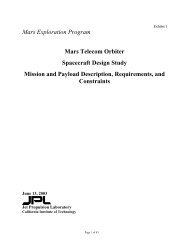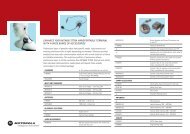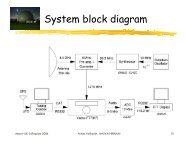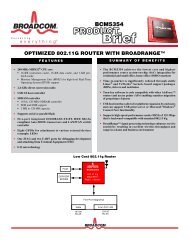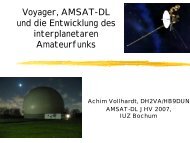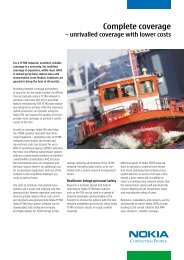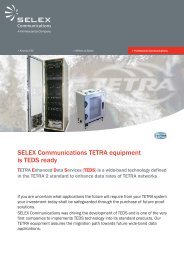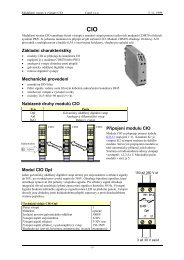BS-T2 TETRA Radio Base Station - Ok1mjo.com
BS-T2 TETRA Radio Base Station - Ok1mjo.com
BS-T2 TETRA Radio Base Station - Ok1mjo.com
Create successful ePaper yourself
Turn your PDF publications into a flip-book with our unique Google optimized e-Paper software.
Avionics CNI > Military & Space<br />
> Professional Communications<br />
<strong>BS</strong>-<strong>T2</strong><br />
<strong>TETRA</strong> <strong>Radio</strong> <strong>Base</strong> <strong>Station</strong><br />
DESCRIPTION<br />
SELEX Communications' <strong>TETRA</strong> (TErrestrial Trunked RAdio)<br />
<strong>Radio</strong> <strong>Base</strong> <strong>Station</strong> (<strong>BS</strong>) series <strong>T2</strong> is a state-of-the-art equipment<br />
in its class.<br />
The <strong>BS</strong> series <strong>T2</strong> is specially designed to cope with the<br />
operational requirements typically requested by professional<br />
users in radio mobile digital networks, for emergency situations<br />
or fast response operation.<br />
<strong>BS</strong>-<strong>T2</strong> is responsible for connecting all the terminals<br />
(handportable, vehicular station, fixed station etc.), located<br />
within its coverage area, to the <strong>TETRA</strong> network infrastructure.<br />
In normal mode of operation each <strong>BS</strong>-<strong>T2</strong> is directly controlled<br />
by one Switching and Control Node (SCN) that connects the<br />
<strong>BS</strong>-<strong>T2</strong> to <strong>TETRA</strong> network.<br />
The link with all the peripherals is obtained through the radio<br />
coverage, in accordance with <strong>TETRA</strong> air interface protocol<br />
standard.<br />
The <strong>TETRA</strong> <strong>BS</strong>-<strong>T2</strong> operates in several bands of the frequency<br />
spectrum fully covering customers requirements and different<br />
operational scenarios.<br />
MAIN FEATURES<br />
SELEX Communications' <strong>BS</strong>-<strong>T2</strong> has 2 main operation modes:<br />
• Normal mode; the <strong>Base</strong> <strong>Station</strong> is directly connected with<br />
a Switching and Control Node (SCN).<br />
• Fallback mode; the <strong>Base</strong> <strong>Station</strong> has no connection with a<br />
SCN and realize a stand alone site.<br />
The main features supported by <strong>BS</strong>-<strong>T2</strong> during normal mode<br />
operation are:<br />
• management of the link with the SCN;<br />
• management of multiple transceivers (TRX) (up to 4 carriers);<br />
• management of up to 2 independent cells with associated<br />
different RF carriers (up to a total number of 4 carriers);<br />
• implementation of <strong>TETRA</strong> air interface protocol up to Layer<br />
2;<br />
• management of security algorithms;<br />
• full Duplex and Half Duplex operation;<br />
• carrier transmission <strong>com</strong>bining;<br />
• 2-way diversity reception capability;<br />
• radio frequency (RF) duplex capability to transmit and receive<br />
on the same antenna;
• fault management relevant to external interfaces (such as<br />
those supporting the SCN link) and internal modules failures;<br />
• status monitoring of internal modules and interface cards;<br />
• alarms report to Network Management System (NMS) and<br />
<strong>BS</strong>-<strong>T2</strong> Local Terminal;<br />
• events and alarms log;<br />
• capability to collect site alarms and drive actuators;<br />
• maintenance and configuration operations both locally and<br />
remotely;<br />
• diagnostic testing activities, using specially devoted tools,<br />
to identify potential anomalies within the equipment.<br />
In case of a failure in the link interconnecting the <strong>BS</strong>-<strong>T2</strong> with<br />
the SCN (or in case of a single site deployment without SCN)<br />
the <strong>BS</strong>-<strong>T2</strong> automatically switches to fallback mode.<br />
In this operation mode the base station provides users, within<br />
the radio coverage, with the following services:<br />
• half and full duplex individual call (both voice and data<br />
transfer);<br />
• group call (both voice and data transfer);<br />
• emergency calls;<br />
• short data message service;<br />
• multi-slot (up to 4 slots) circuit mode data.<br />
The following features are also available:<br />
• management of multiple transceiver (up to 4 carriers) and<br />
cells (up to 2);<br />
• automatic reconfiguration in case of failure of a transceiver;<br />
• user management a simplified form;<br />
• implementation of <strong>TETRA</strong> air interface protocol up to Layer<br />
3;<br />
• Full Duplex and Half Duplex operation;<br />
• carrier transmission <strong>com</strong>bining;<br />
• 2-way diversity reception capability;<br />
• RF duplex capability to transmit and receive on the same<br />
antenna;<br />
• status monitoring and fault management of internal modules;<br />
• alarms report to <strong>BS</strong>-<strong>T2</strong> Local Terminal;<br />
• events and alarms log;<br />
• capability to collect site alarms and to drive actuators;<br />
• local maintenance and configuration operations;<br />
• diagnostic testing activities, using specially devoted tools,<br />
to identify potential anomalies within the equipment.<br />
The <strong>BS</strong>-<strong>T2</strong> is specifically designed in order to support a high<br />
level of performance on a 24 hours a day basis, also in case<br />
of failure of some of the internal modules or of network<br />
infrastructure. The high level of fault tolerance is obtained due<br />
to the following peculiar features of <strong>BS</strong>-<strong>T2</strong>:<br />
• modular architecture;<br />
• redundancy of major modules and main power supply;<br />
• capability of self-reconfiguration in case of failures;<br />
• capability of working in a stand-alone mode without the link<br />
with the SCN;<br />
• capabilities of working also without main power supply (220<br />
VAC).<br />
In each site an external UPS (Uninterruptible Power Supply) is<br />
available, and it is equipped with a battery pack suitably sized.<br />
During normal conditions, the UPS connected to the AC power<br />
supply will supply the <strong>BS</strong>-<strong>T2</strong> (-48 VDC) and will charge the<br />
battery pack so that, in case of the main power supply failure,<br />
the batteries provide proper supply to the <strong>BS</strong><strong>T2</strong>.<br />
<strong>BS</strong>-<strong>T2</strong> is usually delivered with at least two transceivers in order<br />
to provide transceiver fault tolerance.<br />
Each transceiver has its own power supply module, and therefore<br />
there is not any dependence among radio transceivers.<br />
TECHNICAL CHARACTERISTICS<br />
Power class (hybrid configuration,<br />
max 2 carriers per antenna):<br />
Power range:<br />
Frequency band:<br />
Duplex spacing:<br />
Diversity:<br />
Power supply:<br />
Bandwidth:<br />
Environmental aspects:<br />
Power consumption:<br />
Class 2 (EN 300 392-2) 44 dBm (25 W), ±2 dB according to ETSI EN 300 394-1 at antenna connectors<br />
10 dB (2 dB steps)<br />
<strong>BS</strong>-400: 380 ÷ 400 MHz / <strong>BS</strong>-430: 410 ÷ 430 MHz / <strong>BS</strong>-470: 450 ÷ 470 MHz / 800 MHz<br />
10 MHz<br />
2 ways<br />
- 48 VDC nominal (positive ground), range -44÷-60 VDC<br />
5 MHz<br />
• Operation: ETSI ETS 300 019-1-3, class 3.1E<br />
• Storage: ETSI ETS 300 019-1-1, class 1.2<br />
• Transportation: ETSI ETS 300 019-1-2, class 2.2<br />
• EMC: Compliant to ETSI EN 301 489-18<br />
• TSU-200: 200 W max. at 48 V DC for redundant configuration<br />
• TTU: 300 W max. for each TRX, at 48 V DC<br />
e-mail: info@selex-<strong>com</strong>ms.<strong>com</strong> • www.selex-<strong>com</strong>ms.<strong>com</strong><br />
Copyright ©2007 SELEX Communications SpA - All rights reserved.<br />
This publication is issued to provide outline information only which (unless agreed by SELEX Communications<br />
SpA in writing) may not be used, applied or reproduced for any purpose or form part of any order or contract or<br />
be regarded as a representation relating to the products or services concerned. SELEX Communications SpA<br />
reserves the right to alter without notice the specification, design or conditions of supply of any product or service.<br />
SELEX Communications logo is a trademark of SELEX Communications SpA.<br />
Printed in Italy. e-P-IT-154/V1/07/Y




